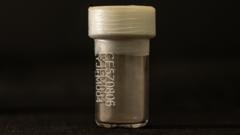
Lunar Samples from Chang'e-5 Mission Arrive in the UK for Pioneering Research
Groundbreaking Collaboration Marks a New Era in Lunar Science
In a historic moment for international scientific collaboration, lunar samples collected by China's Chang'e-5 mission have arrived in the United Kingdom. This marks the first time in nearly half a century that lunar material has been loaned to the UK for scientific analysis, opening exciting new avenues for understanding the Moon's formation, evolution, and potential resources.
The samples, meticulously gathered from the lunar surface in late 2020, represent a significant advancement in lunar exploration. Chang'e-5 was China's first sample-return mission, successfully retrieving approximately 1.73 kilograms of lunar material from a previously unexplored region of the Moon – Oceanus Procellarum, or "Ocean of Storms." This region is known for its relatively young volcanic activity, making these samples particularly valuable to scientists.
Unlocking Lunar Secrets: The Focus of UK Research
The UK research teams receiving the lunar samples will focus on a range of cutting-edge analyses. These studies aim to provide unprecedented insights into:
- Lunar Volcanism: Investigating the composition and age of the volcanic rocks to understand the processes that shaped the Moon's surface.
- Dating Lunar Events: Precisely dating the samples to create a more accurate timeline of lunar geological history.
- Space Weathering: Analyzing the effects of solar wind and micrometeorite impacts on the lunar surface.
- Isotopic Analysis: Examining the isotopic composition of the samples to determine their origin and relationship to other solar system bodies.
A Milestone in International Cooperation
The loan of the Chang'e-5 lunar samples underscores the growing importance of international collaboration in space exploration. This partnership between China and the UK highlights a shared commitment to advancing scientific knowledge and understanding our place in the universe.
The samples were officially handed over to UK researchers following rigorous quarantine and handling procedures to ensure the integrity of the material and prevent any potential contamination. The designated laboratories are equipped with state-of-the-art analytical instruments capable of performing a wide range of analyses at the micro and nano-scales.
The Scientific Significance of the Chang'e-5 Samples
The Chang'e-5 mission was particularly significant because it targeted a region of the Moon that is geologically younger than the Apollo and Luna landing sites. The Apollo missions, conducted by the United States between 1969 and 1972, and the Luna program, conducted by the Soviet Union, provided invaluable insights into the Moon's history. However, the samples collected during those missions were primarily from older, heavily cratered regions.
The younger age of the Chang'e-5 samples offers a unique opportunity to calibrate the lunar cratering rate, which is used to estimate the ages of planetary surfaces throughout the solar system. By precisely dating the Chang'e-5 samples, scientists can refine their understanding of the impact history of the inner solar system.
Future Implications for Lunar Exploration
The UK's involvement in the analysis of the Chang'e-5 samples strengthens its position as a leading center for space science research. The data obtained from these studies will not only advance our understanding of the Moon but also inform future lunar exploration missions, including plans for resource utilization and potential human outposts.
The successful analysis of these samples will pave the way for future collaborations and data sharing among international space agencies, accelerating the pace of lunar science and exploration.
Key Research Areas and Expected Outcomes:
- Determining the Age of the Lunar Surface: Using radiometric dating techniques to precisely determine the age of the rocks and minerals.
- Analyzing the Mineral Composition: Identifying and quantifying the different minerals present in the samples to understand their formation conditions.
- Investigating Volcanic Processes: Studying the textures and chemical compositions of volcanic rocks to understand the nature of lunar volcanism.
- Assessing the Effects of Space Weathering: Examining the changes caused by solar wind and micrometeorite impacts on the lunar surface.
The findings from these research efforts are expected to be published in peer-reviewed scientific journals, contributing to the collective knowledge of the Moon and the solar system.
